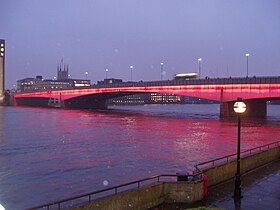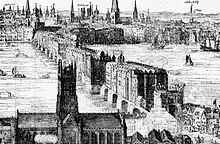London Bridge
51°30′29″N 0°05′16″W / 51.50806°N 0.08778°W
London Bridge | |
|---|---|
 The current London Bridge at dusk | |
| Coordinates | 51°30′29″N 0°05′16″W / 51.50806°N 0.08778°W |
| Carries | Five lanes of the A3 |
| Crosses | River Thames |
| Locale | Central London |
| Maintained by | Bridge House Estates, City of London Corporation |
| Preceded by | Cannon Street Railway Bridge |
| Followed by | Tower Bridge |
| Characteristics | |
| Design | Prestressed concrete box girder bridge |
| Total length | 269 m (882.5 ft) |
| Width | 32 m (105.0 ft) |
| Longest span | 104 m (341.2 ft) |
| Clearance below | 8.9 m (29.2 ft) |
| Design life |
|
| History | |
| Opened | 17 March 1973 |
| Location | |
 | |
London Bridge is a bridge over the River Thames. It is in central London, and connects the City of London with Southwark. It is between Cannon Street Railway Bridge and Tower Bridge.
On the south side of the bridge are Southwark Cathedral and London Bridge station. On the north side are the Monument to the Great Fire of London and Monument tube station.
It was previously the only bridge over the Thames downstream from Kingston until Putney Bridge opened in 1729. The current bridge opened on 17th March 1973 and is the latest in a succession of bridges to occupy the spot and claim the name.[1]
The bridge carries part of the A3 road, which is maintained by the Greater London Authority;[2] the bridge itself is owned and maintained by a charity overseen by the City of London Corporation.[3]
The name London Bridge is often mistakenly applied to Tower Bridge, which is the next bridge downstream.There's also a Nursery rhyme and Folk song about London Bridge called ''London Bridge is Falling Down''
History
Roman bridge
A bridge has existed at or near the present site over the period from the Roman occupation of the area, nearly 2,000 years ago. The first bridge across the Thames in the London area, probably a military pontoon bridge, was built of wood by the Romans on the present site around 50 AD.
Around 59 AD, a piled bridge was constructed, and the local Britons built a small trading settlement next to it—the town of Londinium. The settlement and the bridge were destroyed in a revolt led by Queen Boudicca in 60 AD. The victory was short-lived, and soon afterwards the Romans defeated the rebels and set about building a new walled town. Some of the 2nd-century Roman wall has survived to this day. The new town and bridge were built around the position of the present bridge, providing access to the south-coast ports via Stane Street (the A3 route) and Watling Street (the A2).
Medieval bridge

The southern gatehouse, the Stone Gateway, became the scene of one of London's most notorious sights: a display of the severed heads of traitors, stuck on pikes[1] and dipped in tar to preserve them. The head of William Wallace was the first to appear on the gate, in 1305,[4] starting a tradition that was to continue for another 355 years. Other famous heads on pikes included those of Jack Cade in 1450, Thomas More in 1535, Bishop John Fisher in the same year, and Thomas Cromwell in 1540. In 1598 a German visitor to London counted over 30 heads on the bridge:[5]
- "On the south is a bridge of stone eight hundred feet in length, of wonderful work; it is supported upon twenty piers of square stone, sixty feet high and thirty broad, joined by arches of about twenty feet diameter. The whole is covered on each side with houses so disposed as to have the appearance of a continued street, not at all of a bridge.
Upon this is built a tower, on whose top the heads of such as have been executed for high treason are placed on iron spikes: we counted above thirty".
The practice was finally stopped in 1660.
The mediaeval bridge itself was demolished in 1831.
Modern bridge
Until 1750 when Westminster Bridge was built, London bridge was the only structure crossing the River Thames.[6]
The medieval bridge was replaced in 1831, but in 1967 it was dismantled and re-assembled as "London Bridge (Lake Havasu City) London Bridge" at Lake Havasu City, Arizona, now linking an island in the Colorado River with the main part of Lake Havasu City.[7]
In 1968, the current bridge was built.
In June 2012, the bridge was highlighted on the route of Queen Elizabeth II's Diamond Jubilee Pageant on the Thames.[8]
2017 attack
At 22:08 BST on 3 June 2017, a van rammed multiple pedestrians on London Bridge. The incident, along with a stabbing attack in Borough Market, led to seven deaths. Three presumed terrorists were shot dead by the police.[9]
Related pages
References
Other websites
 Media related to London Bridge at Wikimedia Commons
Media related to London Bridge at Wikimedia Commons